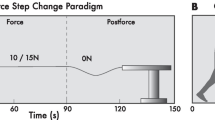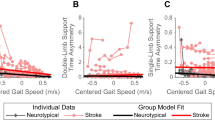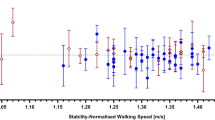Abstract
The aim of this study was to examine how kinematic synergies are utilised as compensatory movements to stabilise foot positions under different walking task constraints in people with stroke. Ten (Males = 6, Females = 4) hemiplegic chronic stroke survivors volunteered to participate in this study, recruited from a rehabilitation centre. They completed a consent form and participated in treadmill walking tasks; flat, uphill, and crossing over a moving obstacle. The uncontrolled manifold method was used to quantify kinematic synergies in the paretic and non-paretic legs during their swing phase. The results of this study showed the strength of synergies was significantly greater in the obstacle task than in the uphill walking tasks at mid and terminal swing phases. In conclusion, the results suggest that walking in the challenging situations caused people with stroke to control step stability with greater compensation between lower extremity joints. Participants adapted to the increased challenge by increasing the amount of ‘good variability’, which could be a strategy to reduce the risks of falling.



Similar content being viewed by others
References
Balasubramanian CK, Neptune RR, Kautz SA (2009) Variability in spatiotemporal step characteristics and its relationship to walking performance post-stroke. Gait Posture 29:408–414
Bernstein N (1967) The coordination and regulation of movements. Pergamon Press, London
Carr JH, Shepherd RB, Nordholm L, Lynne D (1985) Investigation of a new motor assessment scale for stroke patients. Phys Ther 65:175–180
Dean JC, Kautz SA (2015) Foot placement control and gait instability among people with stroke. J Rehabil Res Dev 52:577–590
Gelfand IM, Latash ML (1998) On the problem of adequate language in movement science. Mot Control 2:306–313
Hutin E, Pradon D, Barbier F, Gracies JM, Bussel B, Roche N (2011) Lower limb coordination patterns in hemiparetic gait: factors of knee flexion impairment. Clin Biomech 26:304–311
Jackson AB, Carnel CT, Read MS, Boninger ML, Schmeler MR, Williams SR, Donovan WH (2008) Outcome measures for gait and ambulation in the spinal cord injury population. J Spinal Cord Med 31:487–499
Janshen L, Santuz A, Ekizos A, Arampatzis A (2017) Modular control during incline and level walking in humans. J Exp Biol 220:807–813
Kao P, Srivastava S (2018) Mediolateral footpath stabilization during walking in people following stroke. PloS One 13:e0208120
Krishnan V, Rosneblatt NJ, Latash ML, Grabiner MD (2013) The effects of age on stabilisation of the mediolateral trajectory of the swing foot. Gait Posture 38:923–928
Latash ML, Scholz JP, Schoner G (2007) Toward a new theory of motor synergies. Mot Control 11:276–308
Liao Y, Yang Y, Wu Y, Wan R (2014) Factors influencing obstacle crossing performance in patients with Parkinson’s Disease. PLoS One 9:e84245
Lowrey CR, Watson A, Vallis LA (2007) Age-related changes in avoidance strategies when negotiating single and multiple obstacles. Exp Brain Res 182:289–299
Lu TW, Yen HC, Chen HL, Hsu WC, Chen SC, Hong SW (2010) Symmetrical kinematic changes in highly functioning older patients post-stroke during obstacle-crossing. Gait Posture 31:511–516
MacLellan MJ, Richards CL, Fung J, McFadyen BJ (2015) Comparison of kinetic strategies for avoidance of an obstacle with either the affected or unaffected as leading limb in persons post stroke. Gait Posture 42:329–334
Manaf H, Justine M, Goh HT (2015) Effects of attentional loadings on gait performance before turning in stroke survivors. PM&R 7:1159–1166
Mattos D, Latash ML, Park E, Kuhl J, Scholz JP (2011) Unpredictable elbow joint perturbation during reaching results in multijoint motor equivalence. J Neurophysiol 106:1424–1436
Moore S, Schurr K, Wales A, Moseley A, Herbert R (1993) Observation and analysis of hemiplegic gait: swing phase. Aus J Physiother 39:271–278
Moseley A, Wales A, Herbert R, Schurr K, Moore S (1993) Observation and analysis of hemiplegic gait: stance phase. Aus J Physiother 39:259–267
Newell KM, Broderick MP, Deutsch KM, Slifkin AB (2003) Task goals and change in dynamical degrees of freedom with motor learning. J Exp Psychol Hum Percept Perform 29:379–387
Novak AC, Deshpande N (2014) Effects of aging on whole body and segmental control while obstacle crossing under impaired sensory conditions. Hum Mov Sci 35:121–130
Olney SJ, Eng J (2011) Gait. In: Levangie PK, Norkin CC (eds) Joint structure and function, 5th edn. Philadelphia, F. A. Davis Company, pp 524–569
Pandy MG, Lin YC, Kim HJ (2010) Muscle coordination of mediolateral balance in normal walking. J Biomech 43:2055–2064
Papi E, Rowe PJ, Pomeroy VM (2015) Analysis of gait within the uncontrolled manifold hypothesis: stabilisation of the centre of mass during gait. J Biomech 48:324–331
Perry J, Burnfield JM (2010) Larger contributions of the hip and knee extensors as well as the stabilizing knee muscles ST and BFL in Syn 1. NJ Slack Inc, Thorofare
Plummer-D’Amato P, Altmann LJP, Saracino D, Fox E, Behrman AL, Marsiske M (2008) Interactions between cognitive tasks and gait after stroke: a dual task study. Gait Posture 27:683–688
Plummer-D’Amato P, Kyvelidou A, Sternad D, Najafi B, Villalobos RM, Zurakowsk D (2012) Training dual-task walking in community-dwelling adults within 1 year of stroke: a protocol for a single-blind randomized controlled trial. BMC Neurol 12:129–137
Qu X (2012) Uncontrolled manifold analysis of gait variability: effects of load carriage and fatigue. Gait Posture 36:325–329
Rankin BL, Buffo SK, Dean JC (2014) A neuromechanical strategy for mediolateral foot placement in walking humans. J Neurophysiol 112:374–383
Rosenblatt NJ, Hurt CP, Latash ML, Grabiner MD (2014) An apparent contradiction: increasing variability to achieve greater precision? Exp Brain Res 232:403–413
Rosenblatt NJ, Latash ML, Hurt CP, Grabiner MD (2015) Challenging gait leads to stronger lower-limb kinematics synergies: the effects of walking within a more narrow pathway. Neurosci Lett 600:110–114
Scholz JP, Schöner G (1999) The uncontrolled manifold concept: identifying control variables for a functional task. Exp Brain Res 126:289–306
Shamay S, Hui-Chan CW (2005) The timed up and go test: its reliability and association with lower-limb impairments and locomotor capacities in people with chronic stroke. Arch Phys Med Rehabil 86:1641–1647
Stanhope VA, Knarr BA, Reisman DS, Higginson JS (2014) Frontal plane compensatory strategies associated with self-selected walking speed in individuals post-stroke. Clin Biomech 29:518–522
Tukoda K, Anan M, Takahashi M, Sawada T, Tanimoto K, Kito N, Shunkoda K (2018) Biomechanical mechanism of lateral trunk lean gait for knee osteoarthritis patients. J Biomech 66:10–17
Van Emmerik REA, Hamill J, McDermott WJ (2005) Variability and coordinative function in human gait. Quest 57:102–123
Winter DA (1987) The biomechanics and motor control of human gait. University of Waterloo Press, Waterloo
Wong AM, Pei YC, Hong WH, Chung CY, Lau YC, Chen CP (2004) Foot contact pattern analysis in hemiplegic stroke patients: an implication for neurologic status determination. Arch Phys Med Rehabil 85:1625–1630
Wu Y, Pazin N, Zatsiorsky VM, Latash ML (2012) Practicing elements versus practicing coordination: changes in the structure of variance. J Mot Behav 44:471–478
Yang JF, Scholz JP (2005) Learning a throwing task is associated with differential changes in the use of motor abundance. Exp Brain Res 163:137–158
Zhang W, Scholz JP, Zatsiorsky VM, Latash ML (2008) What do synergies do? Effects of secondary constraints on multi-digit synergies in accurate force-production tasks. J Neurophysiol 99:500–513
Author information
Authors and Affiliations
Corresponding author
Ethics declarations
Conflict of interest
The authors have not received any financial support in this study and declare no conflict of interest.
Additional information
Publisher's Note
Springer Nature remains neutral with regard to jurisdictional claims in published maps and institutional affiliations.
Appendix: Details of the UCM method adapted from Krishnan et al (2013)
Appendix: Details of the UCM method adapted from Krishnan et al (2013)
Creating a model for elemental variables
The UCM method that is used in this study has 10 elemental variables and 1 performance variable (mediolateral trajectory of swing foot). A geometric model was created to relate elemental variables to the performance variable. This comprised a five-segment and 10 DoFs model (Fig. 1). The segments were stance leg, pelvis, swing-leg thigh and swing-leg shank with lengths L1, L2, L3, and L4 respectively. For the paretic swing leg in gait cycle, 5 DoFs are in the frontal plane, Ɵ1 = stance-leg shanknon-paretic, Ɵ2 = stance-leg thighnon-paretic, Ɵ3 = pelvis, Ɵ4 swing-leg thighparetic and Ɵ5 = swing-leg shankparetic, and 4 DoFs are out of the frontal plane; α1 = stance-leg shanknon-paretic, α2 = stance-leg thighnon-paretic, α3 = pelvis, α4 = swing-leg thighparetic and s5 = swing-leg shankparetic. The same model is used when for the non-paretic swing leg.
Segmental configuration
An ankle joint trajectory (AJT) and functions of ten DoFs (\(\underset{\raise0.3em\hbox{$\smash{\scriptscriptstyle-}$}}{\varTheta }\)) from the segmental model was created by a custom-written code in Matlab 2018a (Mathworks, Natick, MA) according to the UCM procedure in Krishnan et al. (2013). Prior to UCM analysis, all segmental configuration and ankle joint trajectory (AJT) data were normalised for swing phases (0–100%):
Calculation of V UCM and V ORT
As geometric models describing the position of an end effector are generally non-linear, uncontrolled manifolds are often curved. Therefore, the first step in calculating \(V_{\text{UCM}}\) and \(V_{\text{ORT}}\) is to perform a linearization around a reference configuration. A linear approximation of the model can be obtained by calculating the Jacobian matrix with respect to a reference configuration—the mean segment configuration across trials (Scholz and Schoner 1999). Deviations of segment vectors, for a particular trial, from the mean segment configuration can then be projected onto the null space (\(\varepsilon\)) of this Jacobian matrix:
where \(n\) is the number of degrees of freedom of the model, \(d\) is the number of dimensions of the performance variable, \(\underset{\raise0.3em\hbox{$\smash{\scriptscriptstyle-}$}}{\varTheta }\) is a vector of segment angles for a particular trial and \(\underset{\raise0.3em\hbox{$\smash{\scriptscriptstyle-}$}}{\varTheta }^{0}\) is a vector of segment angles in the reference configuration. For this work, n = 10 and d = 1. A component of the deviation of \(\underset{\raise0.3em\hbox{$\smash{\scriptscriptstyle-}$}}{\varTheta }\) from \(\underset{\raise0.3em\hbox{$\smash{\scriptscriptstyle-}$}}{\varTheta }^{0}\) that is perpendicular to the UCM can also be calculated as:
The variability per degree of freedom parallel (\(V_{\text{UCM}}\)) and perpendicular (\(V_{\text{ORT}}\)) to the UCM was then calculated using:
and
where N is the number of stride. VUCM does not affect the variance in the mediolateral foot trajectory (Good variability), whereas VORT causes the variance in the foot trajectory (Bad variability).
Motor synergy index
If VUCM > VORT, then lower limb synergy stabilise the foot trajectory in a gait cycle. A synergy index was calculated as:
where
n = number of DoFs; d = number of performance variable.
The more positive ΔV, the stronger the motor synergy among segments. If VORT = 0, then ΔV = 10/9 and all variance lie within the UCM. If all variance lies in the orthogonal sub-space (VUCM = 0), ΔV = − 10. For consistency among studies, ΔV was transformed to Fisher’s z-transformation index:
Rights and permissions
About this article
Cite this article
Shafizadeh, M., Wheat, J., Kelley, J. et al. Stroke survivors exhibit stronger lower extremity synergies in more challenging walking conditions. Exp Brain Res 237, 1919–1930 (2019). https://doi.org/10.1007/s00221-019-05560-9
Received:
Accepted:
Published:
Issue Date:
DOI: https://doi.org/10.1007/s00221-019-05560-9




